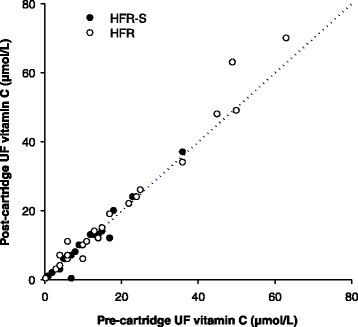Vitamins (A, C and E) and oxidative status of hemodialysis patients treated with HFR and HFR-Supra
- PMID: 27566671
- PMCID: PMC5002141
- DOI: 10.1186/s12882-016-0315-6
Vitamins (A, C and E) and oxidative status of hemodialysis patients treated with HFR and HFR-Supra
Abstract
Background: Hemodiafiltration with on-line endogenous reinfusion (HFR) is an extracorporeal dialytic method that combines diffusion, convection and adsorption. HFR-Supra (HFR-S) is a second-generation system with increased convective permeability and adsorption capability. Previous studies suggested that HFR reduces oxidative stress compared to standard haemodialysis. The principal aim of the present study was to compare antioxidant vitamins behavior and oxidative status of hemodialysis patients treated with HFR and HFR-S.
Methods: The study was designed as a multicenter, randomized, crossover trial. Forty-one patients were recruited from 19 dialysis centers and after a 4-month washout stabilization period in on-line hemodiafiltration (ol-HDF), each patient was randomized to a sequence of treatments (HFR-S followed by HFR or viceversa) with each treatment applied over 6 months. Plasma levels of Advanced Oxidation Protein Products, Total Antioxidant Status, vitamins C, A and E and their ligands (Retinol Binding Protein and total lipids) were measured at baseline and at the end of each treatment period.
Results: Results show that the higher convective permeability of HFR-S with respect to HFR did not produce additional beneficial effects on the patients' oxidative status, a slight decrease of both Vitamin A and Retinol Binding Protein being the only difference registered in the long-term. However, as compared to ol-HDF, both the re-infusive techniques allowed to reduce the intradialytic loss of Vitamin C and, in the long-term, improve the patients' oxidative status and increase Retinol Binding Protein plasma values. No significant differences were found between the Vitamin C concentration of pre- and post cartridge UF neither in HFR-S nor in HFR showing that the sorbent resin does not adsorb Vitamin C.
Conclusion: HFR-S and HFR are almost equivalent in term of impact on antioxidant vitamins and oxidative status of hemodialysis patients. Nonetheless, as compared to ol-HDF, both treatments produced a sensible sparing of Vitamin C and may represent a new approach for reducing oxidative stress and related complications in dialysis patients. Long-term effects of re-infusive treatments on patients' cardiovascular morbidity and mortality need to be evaluated.
Trial registration: ClinicalTrials.gov Identifier NCT01492491 , retrospectively registered in 10 December 2011.
Keywords: Adsorption; Antioxidants; HFR; Hemodiafiltration; High permeability; Oxidative stress; Vitamins.
Figures




References
Publication types
MeSH terms
Substances
Associated data
LinkOut - more resources
Full Text Sources
Other Literature Sources
Medical

